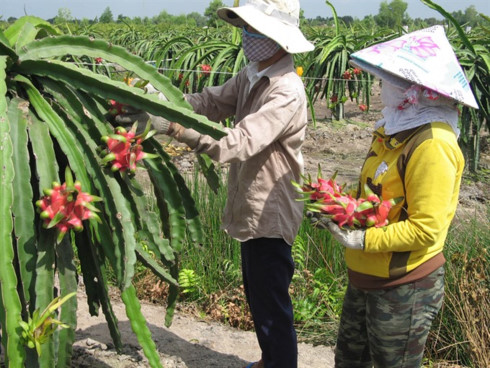Branding agribusiness commodities for adding value
- Fruit, vegetable exports hit US$1.38 billion in five months
- Credit package for hi-tech agriculture hoped to become fruitful
- Dragon fruit farmers supported with energy-saving lights
This is most noticeable in the larger metropolitan areas of Hanoi, Danang and Ho Chi Minh City, said leading economist Tran Dinh Thien at a recent forum discussing branding and geographical indicators.
Some studies have shown that food commodities in the country have the potential to gain 55-65% in value while fruit could grow 30-40% and vegetables 40-50%, he and other speakers at the forum noted.
As a result, said the speakers at the event, there is a need for branding to narrow the gap between the amount paid to the producer by the distributor and that paid by the consumer to the supermarket.
 |
It is important to recognize that agribusiness has had very little success anywhere in the globe using traditional branding strategies for commodities. In the US, two notable exceptions are Dole pineapple and Chiquita bananas.
A more common method of creating differentiation for commoditized products is based on varietal differences. The best example of this can be seen in apples as growers and producers label their products Gala, Jonathon, Granny Smith or Braeburn.
Although these labels allow for some limited differentiation, they are not true brands in the traditional sense because any business can produce and put these labels on their apples.
The most promising new development is the use of geographical origin as a basis for branding commodities, which is used in European and increasingly becoming more common in American markets.
In the US, brands such as Florida Oranges, Idaho Potatoes, Maine Lobster, Napa Valley Wine, and Washington State Apples are all examples of geographical indication brands that have gained prominence.
With such GI protection, producers can command premium prices for their products, especially if perceived and/or actual quality differences exist, including product differences attributable to their unique geographical as opposed to varietal origins.
Other examples of GI protected products in the EU include Scotch, Champagne, and Cognac. India has its Darjeeling tea, Sri Lanka its Ceylon tea, Guatemala its Antigua coffee, and Switzerland its Etivaz cheese.
GIs allow producers to create an image of uniqueness or scarcity that enables them to obtain premium prices for products that would otherwise be ascribed commodity status.
The main source of this differentiation comes from exclusive quality differences that may be attributed to production in a specific geographical area based on quality characteristics associated with that location.
Good examples in Vietnam are that of Da Lat vegetables or Buon Ma Thuot coffee, which are already developing a solid GI brand image nationally but have yet to gain prominence in the international marketplace.
One of the big advantages for GIs in Vietnam is that they are not owned by a single producer but rather by a collective of companies operating in a geographical region such as Da Lat.
Accordingly, in Vietnam individual agribusinesses can develop a brand image by labelling their products with their corporate/brand name, a varietal brand such as Gala apples as well as the GI indicator Da Lat or Buon Ma Thuot.
Simply put, that is three different tools a business can utilize to brand its product.
GIs are particularly significant in terms of cost or investment to develop a brand image, which can run into the tens of millions of dollars and is out of reach of a typical agribusiness operating in Vietnam.
One should also keep firmly in mind the fact that many Vietnamese commodities that are sold in foreign markets already have a GI indicator of sorts, though it may not be legally recognized as such.
Every package of frozen shrimp that is sold in the US market, for example, is clearly labelled ‘Product of Vietnam’ on its package. So regardless of the corporate brand, every customer in the US unmistakeably knows the shrimp they are buying originated from Vietnam.
This awareness by the customer does indeed create a brand image of Vietnamese products for such items as shrimp, fish, coffee and tea among others— and is a fact that is far too often overlooked by those in Vietnam who advocate developing a brand for commodities.
The cultivation of this brand image in the international marketplace is the only way for Vietnam agribusiness to escape from merely competing on volume and price alone. Good brand images help to differentiate products as they enhance their value beyond their functional attributes.
They build a preference among global consumers over competing products and therefore create long-term sustainable competitive advantage.
The association with poor or inconsistent quality that Vietnam currently has most often leads to the need for discounted prices, whereas the nurturing of the GI brand image leads to superior quality of branded produce.
Increasingly Vietnamese consumers are learning that ‘cheap and best’ cannot possibly coexist. Vietnamese agribusiness must now learn that continuous effort need be put to quality first and foremost and secondarily highlighting the superior quality of branded produce.
At the forum, Luu Duc Thanh from the National Office of Intellectual Property of Vietnam said the number of applications for GIs currently stands at just 52, a figure that should register in the tens of thousands.

